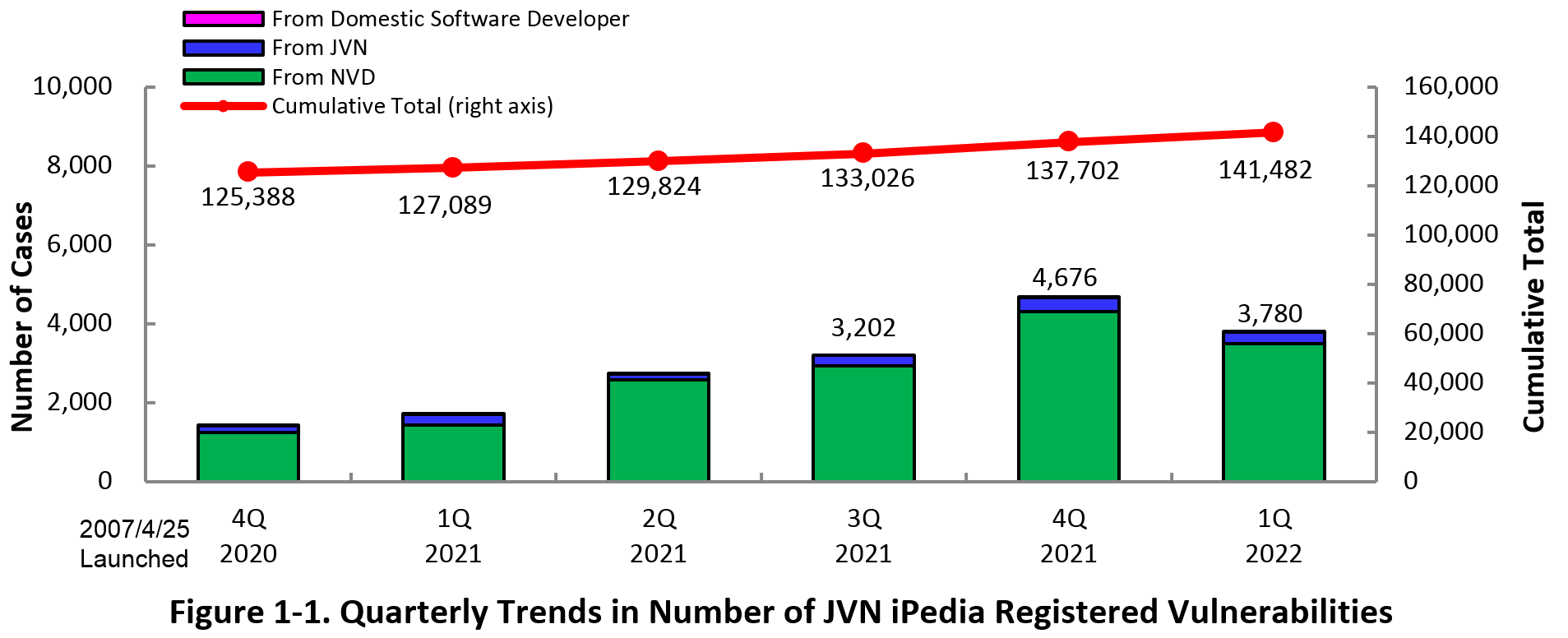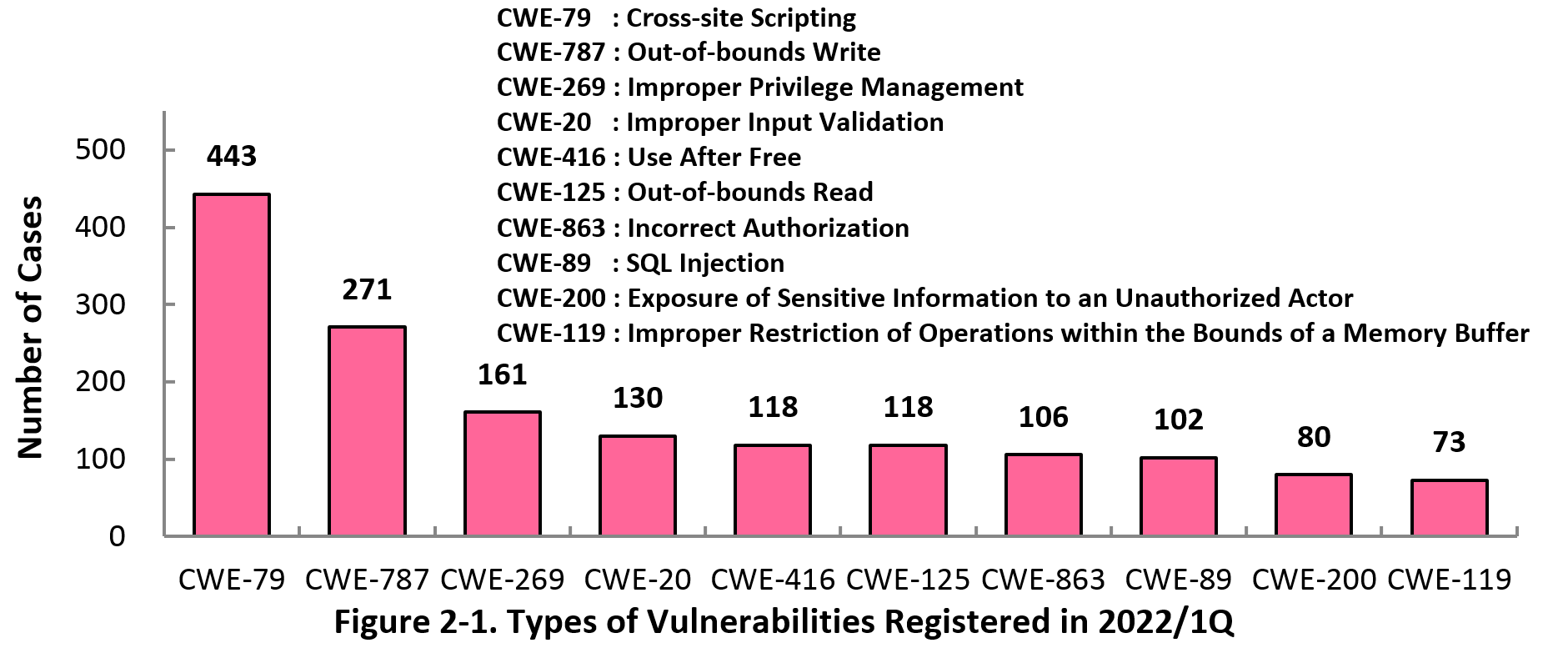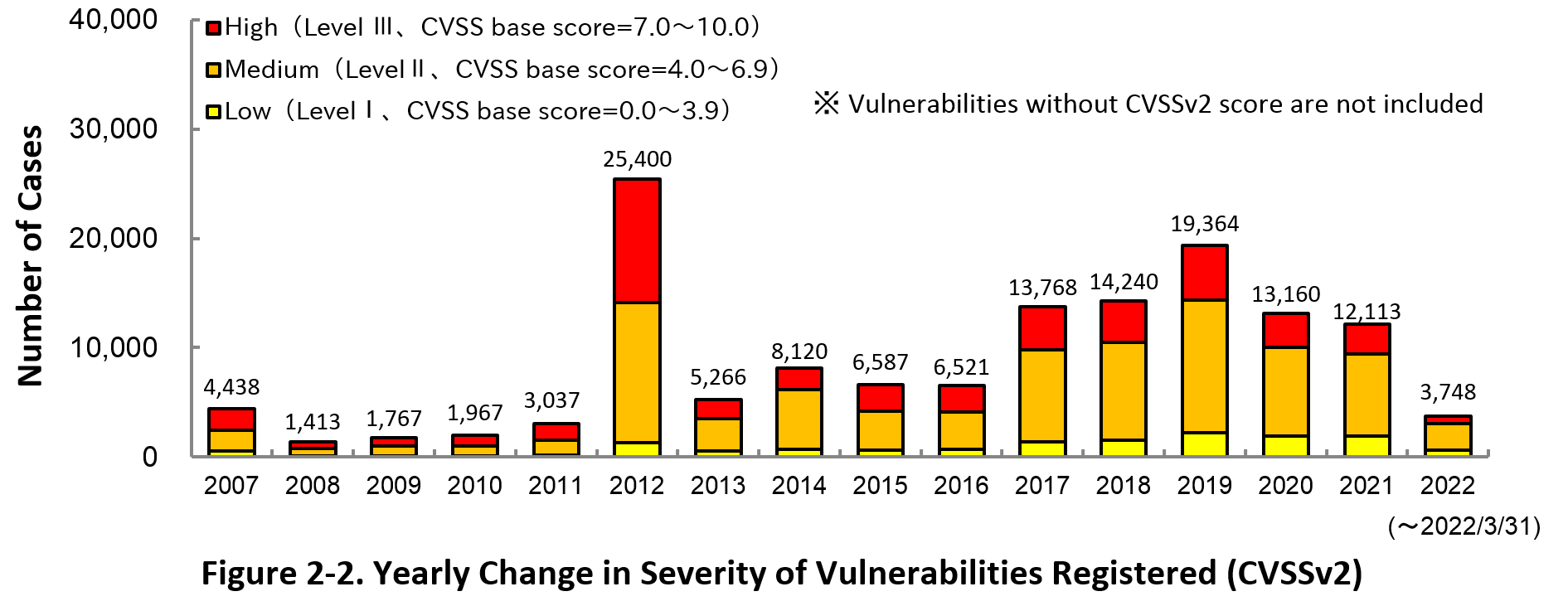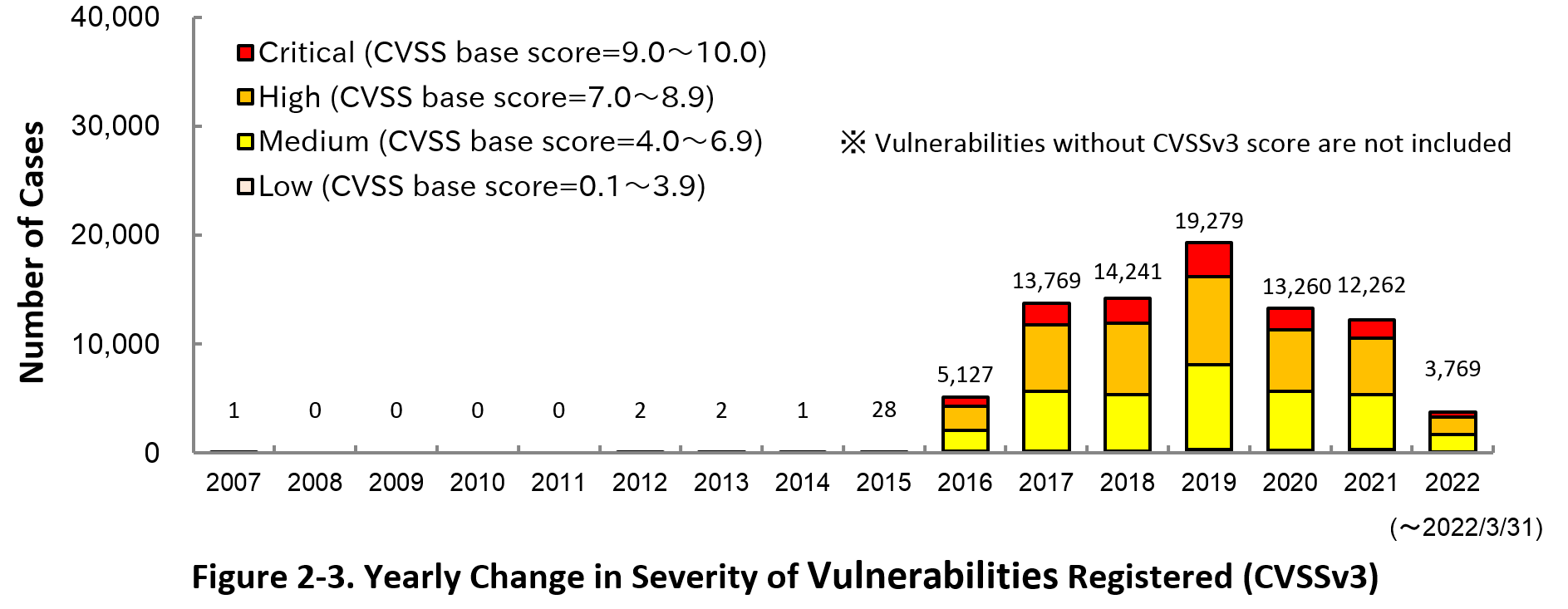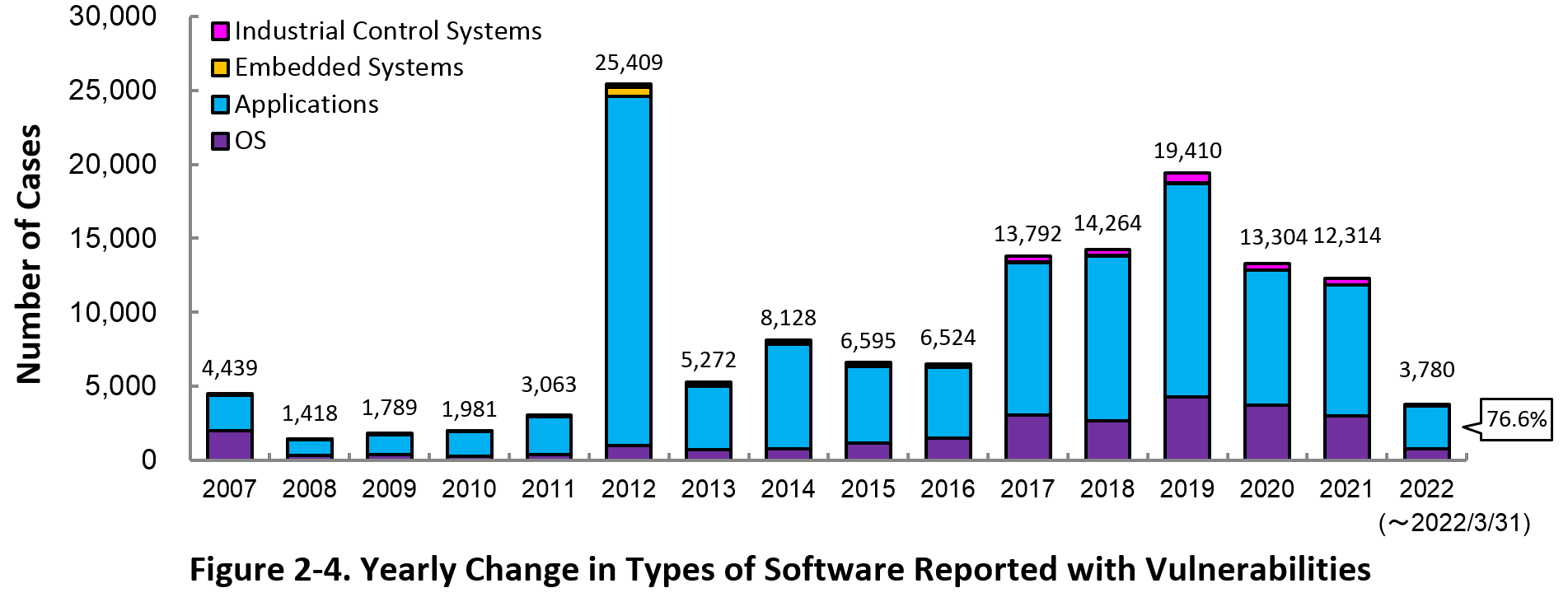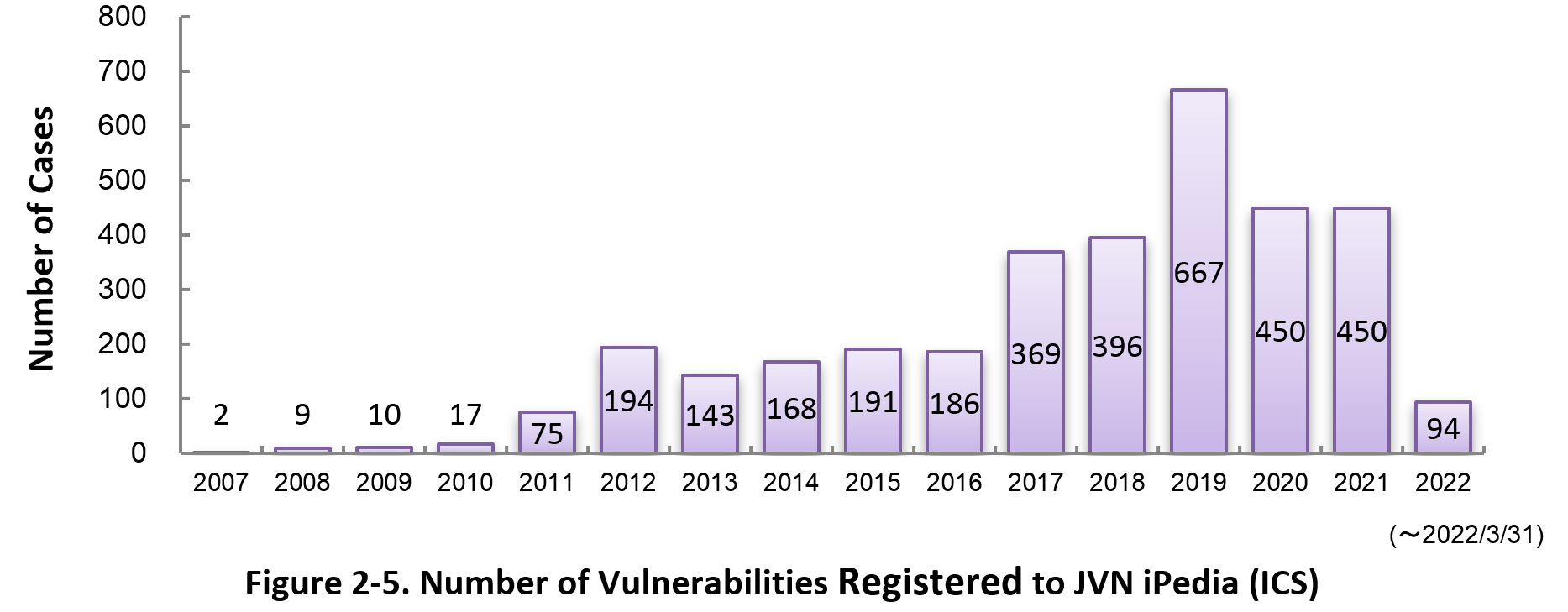Enhancing information security

Vulnerability Countermeasure Information Database JVN iPedia Registration Status [2022 1st Quarter (Jan. - Mar.)]
Release Date:May 25, 2022
IT Security Center
1. 2022 1st Quarter: Vulnerability Countermeasure Information Database JVN iPedia Registration Status
The vulnerability countermeasure information database JVN iPedia (https://jvndb.jvn.jp/en/) is endeavoring to become a comprehensive vulnerability database where vulnerability information is aggregated for easy access for IT users. JVN iPedia collects and/or translates the vulnerability information published by 1) domestic software developers, 2) JVN (*1), a vulnerability information portal run by JPCERT/CC and IPA, and 3) NVD (*2), a vulnerability database run by NIST (*3). JVN iPedia has been making vulnerability information available to the public since April 25, 2007.
1-1. Vulnerabilities Registered in 2022/1Q
~ JVN iPedia now stores 141,482 vulnerabilities ~
The summary of the vulnerability information registered to the Japanese version of JVN iPedia during the 1st quarter of 2022 (January 1 to March 31, 2022) is shown in the table below. As of the end of March 2022, the total number of vulnerabilities stored in JVN iPedia is 141,482 (Table 1-1, Figure 1-1).
As for the JVN iPedia English version, the total number of vulnerabilities stored is 2,414 as shown in the lower half of the Table 1-1.
Table 1-1. Vulnerabilities Registered to JVN iPedia during 1st Quarter of 2022
|
|
Information Source
|
Registered Cases
|
Cumulative Cases
|
|---|---|---|---|
|
Japanese Version
|
Domestic Product Developers
|
3 cases
|
264 cases
|
|
JVN
|
289 cases
|
11,135 cases
|
|
|
NVD
|
3,488 cases
|
130,083 cases
|
|
|
Total
|
3,780 cases
|
141,482 cases
|
|
|
English Version
|
Domestic Product Developers
|
3 cases
|
259 cases
|
|
JVN
|
36 cases
|
2,155 cases
|
|
|
Total
|
39 cases
|
2,414 cases
|
2. Details on JVN iPedia Registered Data
2-1. Types of Vulnerabilities Reported
Figure 2-1 shows the number of vulnerabilities newly added to JVN iPedia during the 1st quarter of 2022, sorted by the CWE vulnerability types.
The type of the vulnerabilities reported most in the 1st quarter is CWE-79 (Cross-site Scripting) with 443 cases, followed by CWE-787 (Out-of-bounds Write) with 271, CWE-269 (Improper Privilege Management) with 161, CWE-20 (Improper Input Validation) with 130, CWE-416 (Use After Free) with 118. CWE-79 (Cross-site Scripting), the most reported vulnerability type in this quarter, could allow attackers to display false webpages and/or steal information.
Software developers need to make sure to mitigate vulnerability from the planning and design phase of software development. IPA provides tools and guidelines, such as "Vulnerability Countermeasure Guide for Software Developers"" (*4), "How to Secure Your Website" (*5), "Secure Programming Guide" (*6) and "AppGoat" (*7), a hands-on venerability learning tool, for website developers and operators to build secure websites.
2-2. Severity of Vulnerabilities Reported
Figure 2-2 shows the yearly change in the CVSSv2 rating scale based severity of vulnerabilities registered to JVN iPedia.
As for the vulnerabilities added to JVN iPedia in 2022, 19.1 percent are “Level III” (7.0 - 10.0), 63.8 percent are “Level ll” (4.0 – 6.9) and 17.1 percent are “Level I” (0.0 – 3.9). This means 82.9 percent of all vulnerabilities registered are Level II or higher, which are potentially critical enough to cause damage like information exposure or data falsification.
Figure 2-3 shows the yearly change in the CVSSv3 rating scale based severity of vulnerabilities registered to JVN iPedia.
As for the vulnerabilities added to JVN iPedia in 2022, 11.5 percent are “Critical” (9.0 – 10.0), 42.3 percent are “High” (7.0 – 8.9), 43.1 percent are “Medium” (4.0 – 6.9) and 3.2 percent are “Low” (0.1 – 3.9).
To avoid threats posed by the known vulnerabilities, both product developers and IT users should pay close attention to vulnerability disclosure and update software they use to a fixed version or apply a security patch as soon as possible when they become available. IT users can check vulnerabilities newly published on JVN iPedia in RSS and XML format (*8) as well.
2-3. Types of Software Reported with Vulnerability
Figure 2-4 shows the yearly change in the type of software reported with vulnerability. Application vulnerabilities have been published most, accounting for 76.6 percent (2,897 out of 3,780) of the 2022 total.
Figure 2-5 shows the yearly change in the number of JVN iPedia-stored vulnerabilities in industrial control systems (ICS) used in critical infrastructure sectors. As of March 2022, the total of 3,421 ICS vulnerabilities have been registered.
2-4. Products Reported with Vulnerability
Table 2-1 lists the top 20 software whose vulnerabilities were most registered to JVN iPedia during the 1st quarter (January to March) of 2022.
In this quarter, the most registered products were Qualcomm products which continued from previous quarter, with 530 cases. This is due to the registration of vulnerability information for multiple Qualcomm products which published in 2021. In addition, OS products, such as Fedora and Microsoft Windows Products, account for 14 of the top 20.
Besides those in the top 20 list, JVN iPedia stores and offers vulnerability information about a variety of software. IPA hopes software developers and users will make good use of JVN iPedia to efficiently check vulnerability information and take necessary action in a timely manner (*9).
Table 2-1. Top 20 most registered software products vulnerability countermeasure information in JVN iPedia [Jan. – Mar. 2022]
|
Rank
|
Category
|
Product Name (Vendor)
|
Number of
Vulnerabilities Registered |
|---|---|---|---|
|
1
|
Firmware
|
Qualcomm component (Qualcomm)
|
530
|
|
2
|
OS
|
Fedora (Fedora Project)
|
192
|
|
3
|
OS
|
Debian GNU/Linux (Debian)
|
156
|
|
4
|
OS
|
Microsoft Windows 10 (Microsoft)
|
136
|
|
5
|
OS
|
Microsoft Windows Server 2019 (Microsoft)
|
130
|
|
5
|
OS
|
Microsoft Windows Server (Microsoft)
|
130
|
|
7
|
OS
|
Microsoft Windows Server 2022 (Microsoft)
|
127
|
|
8
|
OS
|
Android (Google)
|
120
|
|
9
|
OS
|
Microsoft Windows 11 (Microsoft)
|
112
|
|
10
|
Others
|
Google TensorFlow (Google)
|
109
|
|
11
|
OS
|
Microsoft Windows Server 2016 (Microsoft)
|
106
|
|
12
|
Others
|
OnCommand Insight (NetApp)
|
99
|
|
13
|
OS
|
Microsoft Windows Server 2012 (Microsoft)
|
90
|
|
14
|
OS
|
Microsoft Windows 8.1 (Microsoft)
|
88
|
|
15
|
OS
|
Microsoft Windows RT 8.1 (Microsoft)
|
83
|
|
16
|
Middleware
|
MySQL (Oracle)
|
76
|
|
17
|
Others
|
OnCommand Workflow Automation (NetApp)
|
73
|
|
18
|
OS
|
Microsoft Windows 7 (Microsoft)
|
62
|
|
19
|
OS
|
Microsoft Windows Server 2008 (Microsoft)
|
61
|
|
20
|
Browser
|
Google Chrome (Google)
|
57
|
3. Most Accessed Vulnerability Countermeasure Information
Table 3-1 lists the top 20 most accessed vulnerability countermeasure information in JVN iPedia during the 1st quarter of 2022 (January to March).
In this quarter, vulnerability countermeasure information of Apache Log4j which was published in December 2021 and attracted so much attention, continued to receive many accesses into 2022, ranking second as it did in the previous quarter.
Vulnerability countermeasure information of Samba in the first ranking, and Vulnerability countermeasure information of WordPress in the third through seventh ranking were due to a lot of access which was considered mechanical from specific organizations.
Rating Scale
Note 1) CVSSv2 Severity Rating Scale
- Level I (Low)
- CVSS Base Score = 0.0~3.9
- Level II (Medium)
- CVSS Base Score = 4.0~6.9
- Level III (High)
- CVSS Base Score = 7.0~10.0
Note 2) CVSSv3 Severity Rating Scale
- Low
- CVSS Base Score =0.1~3.9
- Medium
- CVSS Base Score =4.0~6.9
- High
- CVSS Base Score =7.0~8.9
- Critical
- CVSS Base Score =9.0~10.0
Table 3-1. Top 20 Most Accessed Vulnerability Countermeasure Information in JVN iPedia [Jan. – Mar. 2022]
No.1 Samba vulnerable to out-of-bounds read JVNDB-2021-006687
- CVSSv2 Severity Rating Scale
-
- Level II (Medium)
- CVSSv2 Base Score
-
4.9
- CVSSv3 Severity Rating Scale
-
- Medium
- CVSSv3 Base Score
-
6.8
- Date Public
-
2022/1/17
- Access Count
-
23,825
No.2 Apache Log4j vulnerable to remote code execution JVNDB-2021-005429
- CVSSv2 Severity Rating Scale
-
- Level III (High)
- CVSSv2 Base Score
-
9.3
- CVSSv3 Severity Rating Scale
-
Critical
- CVSSv3 Base Score
-
10.0
- Date Public
-
2021/12/14
- Access Count
-
15,366
No.3 WordPress vulnerable to cross-site scripting JVNDB-2020-006788
- CVSSv2 Severity Rating Scale
-
Level I (Low)
- CVSSv2 Base Score
-
3.5
- CVSSv3 Severity Rating Scale
-
Low
- CVSSv3 Base Score
-
2.4
- Date Public
-
2020/7/17
- Access Count
-
10,057
No.4 WordPress vulnerable to cross-site scripting JVNDB-2020-006830
- CVSSv2 Severity Rating Scale
-
Level I (Low)
- CVSSv2 Base Score
-
3.5
- CVSSv3 Severity Rating Scale
-
Medium
- CVSSv3 Base Score
-
5.4
- Date Public
-
2020/7/20
- Access Count
-
9,237
No.5 WordPress vulnerable to cross-site scripting JVNDB-2020-006831
- CVSSv2 Severity Rating Scale
-
Level I (Low)
- CVSSv2 Base Score
-
3.5
- CVSSv3 Severity Rating Scale
-
Medium
- CVSSv3 Base Score
-
6.8
- Date Public
-
2020/7/20
- Access Count
-
8,372
No.6 WordPress vulnerable to URL redirection to untrusted site ('Open Redirect') JVNDB-2020-006832
- CVSSv2 Severity Rating Scale
-
- Level II (Medium)
- CVSSv2 Base Score
-
4.9
- CVSSv3 Severity Rating Scale
-
- Medium
- CVSSv3 Base Score
-
5.7
- Date Public
-
2020/7/20
- Access Count
-
7,916
No.7 WordPress vulnerable to authentication bypass using an alternate path or channel JVNDB-2020-006893
- CVSSv2 Severity Rating Scale
-
- Level II (Medium)
- CVSSv2 Base Score
-
6.0
- CVSSv3 Severity Rating Scale
-
Low
- CVSSv3 Base Score
-
3.1
- Date Public
-
2020/7/22
- Access Count
-
7,473
No.8 EDK II vulnerable to out-of-bounds write JVNDB-2021-008164
- CVSSv2 Severity Rating Scale
-
Level II (Medium)
- CVSSv2 Base Score
-
4.6
- CVSSv3 Severity Rating Scale
-
Medium
- CVSSv3 Base Score
-
6.7
- Date Public
-
2022/3/4
- Access Count
-
7,068
No.9 Multiple vulnerabilities in Cybozu Office JVNDB-2021-000022
- CVSSv2 Severity Rating Scale
-
Level II (Medium)
- CVSSv2 Base Score
-
4.0
- CVSSv3 Severity Rating Scale
-
Medium
- CVSSv3 Base Score
-
4.3
- Date Public
-
2021/3/15
- Access Count
-
6,497
No.10 Multiple vulnerabilities in IDEC PLCs JVNDB-2021-006117
- CVSSv2 Base Score
-
-
- CVSSv3 Severity Rating Scale
-
High
- CVSSv3 Base Score
-
7.6
- Date Public
-
2021/12/27
- Access Count
-
6,410
No.11 Multiple missing authorization vulnerabilities in WordPress Plugin "Advanced Custom Fields" JVNDB-2021-000109
- CVSSv2 Severity Rating Scale
-
- Level II (Medium)
- CVSSv2 Base Score
-
4.0
- CVSSv3 Severity Rating Scale
-
- Medium
- CVSSv3 Base Score
-
4.3
- Date Public
-
2021/12/2
- Access Count
-
5,903
No.12 Label printers "TEPRA" PRO SR5900P / SR-R7900P vulnerable to insufficiently protected credentials JVNDB-2022-000004
- CVSSv2 Severity Rating Scale
-
- Level I (Low)
- CVSSv2 Base Score
-
3.3
- CVSSv3 Severity Rating Scale
-
Medium
- CVSSv3 Base Score
-
4.3
- Date Public
-
2022/1/13
- Access Count
-
5,770
No.13 Multiple vulnerabilities in KONICA MINOLTA MFPs and printing systems JVNDB-2021-006146
- CVSSv2 Base Score
-
-
- CVSSv3 Severity Rating Scale
-
Medium
- CVSSv3 Base Score
-
6.4
- Date Public
-
2021/12/28
- Access Count
-
5,756
No.14 Jimoty App for Android uses a hard-coded API key for an external service JVNDB-2022-000003
- CVSSv2 Severity Rating Scale
-
Level I (Low)
- CVSSv2 Base Score
-
2.1
- CVSSv3 Severity Rating Scale
-
Medium
- CVSSv3 Base Score
-
4.0
- Date Public
-
2022/1/12
- Access Count
-
5,623
No.15 PASSWORD MANAGER "MIRUPASS" PW10 / PW20 missing encryption JVNDB-2022-000005
- CVSSv2 Severity Rating Scale
-
Level II (Medium)
- CVSSv2 Base Score
-
4.9
- CVSSv3 Severity Rating Scale
-
Medium
- CVSSv3 Base Score
-
4.6
- Date Public
-
2022/1/13
- Access Count
-
5,538
No.16 Multiple vulnerabilities in WordPress Plugin "Quiz And Survey Master" JVNDB-2022-000002
- CVSSv2 Severity Rating Scale
-
- Level II (Medium)
- CVSSv2 Base Score
-
4.0
- CVSSv3 Severity Rating Scale
-
- Medium
- CVSSv3 Base Score
-
5.4
- Date Public
-
2022/1/12
- Access Count
-
5,524
No.17 Multiple ESET products for macOS vulnerable to improper server certificate verification JVNDB-2016-008013
- CVSSv2 Severity Rating Scale
-
- Level II (Medium)
- CVSSv2 Base Score
-
4.0
- CVSSv3 Severity Rating Scale
-
Medium
- CVSSv3 Base Score
-
4.8
- Date Public
-
2017/4/10
- Access Count
-
5,292
No.18 HPE Agentless Management registers unquoted service paths JVNDB-2022-000011
- CVSSv2 Severity Rating Scale
-
Level II (Medium)
- CVSSv2 Base Score
-
6.8
- CVSSv3 Severity Rating Scale
-
High
- CVSSv3 Base Score
-
8.2
- Date Public
-
2022/2/9
- Access Count
-
5,132
No.19 Multiple cross-site scripting vulnerabilities in php_mailform JVNDB-2022-000006
- CVSSv2 Severity Rating Scale
-
Level II (Medium)
- CVSSv2 Base Score
-
4.3
- CVSSv3 Severity Rating Scale
-
Medium
- CVSSv3 Base Score
-
6.1
- Date Public
-
2022/1/20
- Access Count
-
5,100
No.20 Multiple vulnerabilities in multiple ELECOM routers JVNDB-2021-004912
- CVSSv2 Base Score
-
-
- CVSSv3 Severity Rating Scale
-
High
- CVSSv3 Base Score
-
8.8
- Date Public
-
2021/12/2
- Access Count
-
5,072
Table 3-2 lists the top 5 most accessed vulnerability information among those reported by domestic product developers.
Table 3-2. Top 5 Most Accessed Vulnerabilities Reported by Domestic Product Developers [Apr. - Jun. 2022]
No.1 Cross-site Scripting Vulnerability in JP1/IT Desktop Management 2 JVNDB-2022-001299
- CVSSv2 Base Score
-
- -
- CVSSv3 Base Score
-
- -
- Date Public
-
2022/2/8
- Access Count
-
4,320
No.2 Multiple Vulnerabilities in JP1/Automatic Operation JVNDB-2021-004432
- CVSSv2 Base Score
-
- -
- CVSSv3 Base Score
-
-
- Date Public
-
2021/11/22
- Access Count
-
4,077
No.3 Cross-site Scripting Vulnerability in Hitachi Infrastructure Analytics Advisor and Hitachi Ops Center Analyzer JVNDB-2021-003840
- CVSSv2 Base Score
-
-
- CVSSv3 Base Score
-
-
- Date Public
-
2021/11/8
- Access Count
-
3,922
No.4 Authentication Bypass Vulnerability in Hitachi Device Manager JVNDB-2021-003660
- CVSSv2 Base Score
-
-
- CVSSv3 Base Score
-
-
- Date Public
-
2021/11/1
- Access Count
-
3,917
No.5 Information Disclosure Vulnerability in Hitachi Tuning Manager, Hitachi Infrastructure Analytics Advisor and Hitachi Ops Center Analyzer JVNDB-2021-002810
- CVSSv2 Base Score
-
-
- CVSSv3 Base Score
-
-
- Date Public
-
2021/10/5
- Access Count
-
3,871
Footnotes
-
(*1)
-
(*2)
-
(*3)
-
(*4)
-
(*5)
-
(*6)
-
(*7)
-
(*8)
-
(*9)
Past Quarterly Reports
Contact information
IT Security Center,
Information-technology Promotion Agency, Japan (ISEC/IPA)

